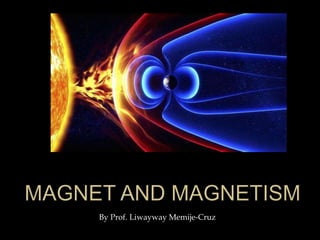
Magnet and magnetism
- 1. By Prof. Liwayway Memije-Cruz
- 2. Magnetism is a phenomenon of physical science that arises due to the forces between objects brought about by the motion of electrical charges within those objects. The motion of electric charges creates a magnetic field, which exerts a magnetic force on charged particles that move within that field. A magnetic field flows from one end of an object to the other, creating a dipole with positive and negative ends.
- 4. All magnets have two types of poles: north- seeking poles or north poles and south-seeking poles or south poles.
- 5. The magnetic strength is the strongest at the poles of the magnet.
- 6. Both Earth’s inner and outer core are metal, but the outer core remains liquid while pressure keeps the inner core solid. The liquid outer core is constantly moving. This moving metal generates a magnetic field around the planet. This magnetic field makes a compass point to north or south. It also protects the planet from the Sun’s harmful rays.
- 7. Heat and the Earth’s spin keep the outer core moving. This movement causes electrical currents in the core, which is mostly iron. The electrical currents create a magnetic field that extends into space. The magnetic field is tilted slightly from the Earth’s axis. Sometimes the magnetic field is stronger than at other times. Sometimes the magnetic field’s alignment moves from the Earth’s spin axis. The magnetic North Pole keeps moving. Right now, the magnetic North Pole is very close to the Earth’s axis. One hundred years ago, it was in Arctic Canada. The magnetic South Pole also moves. The magnetosphere is the magnetic force that extends into space. This force acts like a shield, protecting the Earth from harmful gases and charged particles that would destroy the atmosphere.
- 8. Magnets are surrounded by magnetic fields. A magnetic field can be thought of as consisting of lines of force. The forces of magnetic attraction and repulsion move along the lines of force.
- 9. • All materials exhibit some degree of magnetic properties, though some are far more magnetic than others. • The degree of magnetism is associated with the degree of mobility of a substance's electrons. • Materials such as iron, in which the electrons are free to flow
- 10. copper, lead, quartz, water, acetone, and carbon dioxide are diamagnetic. very weakly affected by magnetic fields. To the extent that they are affected, they become magnetically
- 11. sodium, oxygen, iron oxide (FeO or Fe2O3), and platinum affected somewhat more strongly than diamagnetic materials, they become polarized parallel to a magnetic field. In a nonuniform magnetic field, they feel a force towards the higher field
- 12. iron, nickel, gadolinium, iron oxide (Fe3O4), Manganese Bismuth (MnBi), and Cobalt Ferrite (CoFe2O4). very strongly affected by magnetic fields. become strongly polarized in the direction of the magnetic field, thus,
- 14. 1. Temporary: Some iron and iron alloys can be easily magnetized by even a weak magnetic field. However, when the magnetic field is removed, the object gradually loses its magnetism. 2. Permanent: Examples are alnico (Aluminum Nickel Cobalt alloy) and ferrites (ceramic-like material that is made from a mix of iron oxides with nickel, strontium, or cobalt). Once they are magnetized, these objects do not easily lose their magnetism. 3. Electromagnets: These are used when a very strong magnet is necessary. Electromagnets are made by placing a metal core inside a coil of wire that is carrying an electrical current. The electricity going through the wire produces a magnetic field. While the electric current is flowing, the core acts as a strong magnet. Computers, TVs, and electric motors use electromagnets.
- 16. Ampere’s Circular Current Theory of Magnetism: Magnetism is closely related to electricity
- 17. considers the molecular alignment of the material. assumes that all magnetic substances are composed of tiny molecular magnets. any unmagnetized material has the magnetic forces of its molecular magnets neutralized by adjacent molecular magnets, thereby eliminating any magnetic effect. a magnetized material will have most of its molecular magnets lined up so that the north pole of each molecule points in one direction, and the south pole faces the opposite direction. material with its molecules thus aligned will then have one effective north pole, and one effective south pole.
- 18. based on the electron spin principle. an electron has a magnetic field about it along with an electric field. The effectiveness of the magnetic field of an atom is determined by the number of electrons spinning in each direction. if an atom has equal numbers of electrons spinning in opposite directions, the magnetic fields surrounding the electrons cancel one another, and the atom is unmagnetized. if more electrons spin in one direction than another, the atom is magnetized.
- 19. • https://micro.magnet.fs u.edu/electromag/java /magneticlines2/ • http://easyscienceforkid s.com/all-about-earths- magnetism/ • https://www.reference.co m/science/magnetism- 10ef33adea83d9d3# • http://webphysics.iupui .edu/webscience/physics_ archive/magneticmateria
